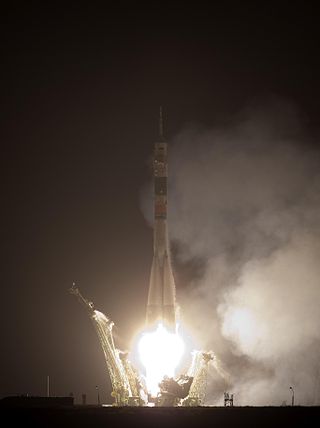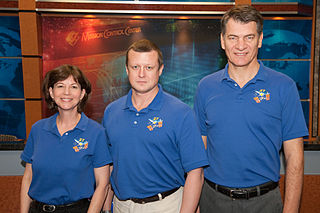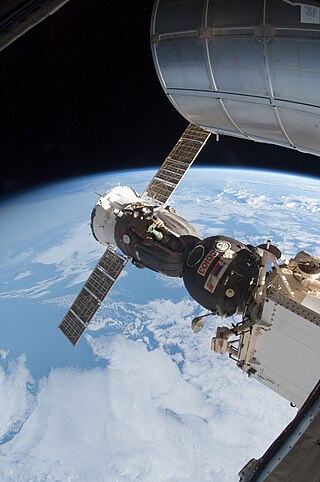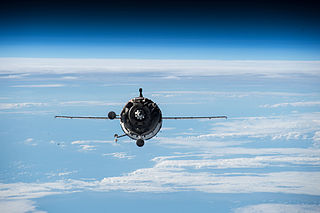
Soyuz TMA-2 was a Soyuz mission to the International Space Station (ISS) launched by a Soyuz FG launch vehicle. The spacecraft docked with the ISS on April 28, 2003 and undocked on October 10, 2003. Soyuz TMA-2 was the second flight for the TMA modification of the Soyuz spacecraft, and the 6th Soyuz to fly to the ISS.

Yuri Ivanovich Malenchenko is a retired Russian cosmonaut. Malenchenko became the first person to marry in space, on 10 August 2003, when he married Ekaterina Dmitrieva, who was in Texas, while he was 240 miles (390 km) over New Zealand, on the International Space Station. As of June 2016, Malenchenko ranks second for career time in space due to his time on both Mir and the International Space Station (ISS). He is a former commander of the International Space Station.

Gennady Ivanovich Padalka is a Russian Air Force officer and a Roscosmos cosmonaut. Padalka currently holds the world record for the most time spent in space, at 879 days. He worked on both Mir and the International Space Station.

Akihiko Hoshide is a Japanese engineer, JAXA astronaut, and former commander of the International Space Station. On August 30, 2012, Hoshide became the third Japanese astronaut to walk in space.

Sergey Aleksandrovich Volkov is a retired Russian cosmonaut and engineer. He was a member of three missions to the International Space Station, spending more than a year in total in space. During his missions he did four spacewalks lasting more than 23 hours in total. Volkov retired from the Cosmonaut group in February 2017.

Soyuz TMA-17 was a human spaceflight mission to the International Space Station (ISS). TMA-17 crew members participated in ISS Expedition 22 and Expedition 23. The mission ended when the Soyuz TMA-17 capsule landed on 2 June 2010.

Soyuz TMA-01M was a Soyuz flight that transported three members of the Expedition 25 crew to the International Space Station. TMA-01M was the 107th flight of a Soyuz spacecraft, and the first flight of the modernized TMA-M series. The spacecraft remained docked to the space station during Expedition 25, to serve as an emergency escape vehicle. The spacecraft's COSPAR ID was 2010-052A.

Soyuz TMA-19 was a crewed spaceflight to the International Space Station (ISS) and is part of the Soyuz programme. It was launched on 15 June 2010 carrying three members of the Expedition 24 crew to the International Space Station, who remained aboard the station for around six months. Soyuz TMA-19 was the 106th crewed flight of a Soyuz spacecraft, since the first mission which was launched in 1967. The spacecraft remained docked to the space station for the remainder of Expedition 24, and for Expedition 25, to serve as an emergency escape vehicle. It undocked from ISS and landed in Kazakhstan on 26 November 2010. It was the 100th mission to be conducted as part of the International Space Station programme since assembly began in 1998.

Soyuz TMA-20 was a human spaceflight to the International Space Station (ISS) and was part of the Soyuz programme. It lifted off from the Baikonur Cosmodrome in Kazakhstan on December 15, 2010, and docked with the ISS two days later. The three-person crew of Soyuz TMA-20 – Dmitri Kondratyev, Catherine Coleman and Paolo Nespoli – represented the ISS partner organizations of Roscosmos, NASA and the European Space Agency (ESA). Soyuz TMA-20's crew represented half of the members of Expedition 27; the other three members of the expedition arrived at the station on board Soyuz TMA-21 on April 6, 2011. The COSPAR ID of Soyuz TMA-20 was 2010-067A. It is ISS flight 25S.

Expedition 29 was the 29th long-duration expedition to the International Space Station (ISS). The expedition formally began on 16 September 2011, with the departure from the ISS of the Soyuz TMA-21 spacecraft. Astronauts Satoshi Furukawa, Michael Fossum and Sergey Volkov, who had arrived at the ISS aboard Soyuz TMA-02M in June 2011, began their Expedition 29 service at this time.

Soyuz TMA-22 was a crewed spaceflight to the International Space Station (ISS). TMA-22 was the 111th flight of a Soyuz spacecraft, and transported three members of the Expedition 29 crew to the ISS. The spacecraft docked to the ISS on 16 November 2011, and remained docked to serve as an emergency escape vehicle until its undocking on 27 April 2012. Soyuz TMA-22 successfully landed in Kazakhstan on 27 April 2012 11:45 GMT.

Soyuz TMA-03M was a spaceflight to the International Space Station (ISS). It launched on 21 December 2011 from Site One at the Baikonur Cosmodrome, Kazakhstan, carrying three members of Expedition 30 to the ISS. TMA-03M was the 112th flight of a Russian Soyuz spacecraft, since the first in 1967, and the third flight of the modernised Soyuz-TMA-M version. The docking with the International Space Station took place at 19:19 Moscow Time on 23 December, three minutes ahead of schedule.

Soyuz TMA-04M was a spaceflight to Low Earth orbit that transported three members of the Expedition 31 crew to the International Space Station (ISS), which was launched on 15 May 2012 and landed on 17 September 2012. TMA-04M was the Soyuz spacecraft's 113th flight since its initial launch in 1967, and the fourth launch of the improved Soyuz TMA-M series. As per the mission plan, the spacecraft remained docked to the space station to serve as an emergency escape vehicle during Expedition 31.

Soyuz TMA-06M was a spaceflight to the International Space Station launched on 23 October 2012, transporting three members of the Expedition 33 crew. TMA-06M was the 115th flight of a Soyuz spacecraft, the first flight launching in 1967. Soyuz TMA-06M launch was also the first crewed flight from the remote Site 31 pad since July 1984.

Soyuz TMA-07M was a spaceflight launched to the International Space Station in 2012 which transported three members of the Expedition 34 crew to the station. The Soyuz remained docked to the space station and served as an emergency escape vehicle for the Expedition 35 increment, before returning its crew to Earth in May 2013.

Soyuz TMA-08M, identified as Soyuz 34 or 34S by NASA, was a 2013 flight to the International Space Station. It transported three members of the Expedition 35 crew to the International Space Station. TMA-08M was the 117th flight of a Soyuz spacecraft, the first flight launching in 1967.

Soyuz TMA-12M was a 2014 flight to the International Space Station. It transported three members of the Expedition 39 crew to the International Space Station. TMA-12M was the 121st flight of a Soyuz spacecraft since the first in 1967 and the 38th Soyuz mission to the ISS.

Soyuz TMA-15M was a 2014 flight to the International Space Station. It transported three members of the Expedition 42 crew to the International Space Station. TMA-15M was the 124th flight of a Soyuz spacecraft, the first flight launching in 1967. The Soyuz remained docked to the space station for the Expedition 43 increment, serving as an emergency escape vehicle until departing and returning to Earth as scheduled in June 2015.

Soyuz TMA-16M was a 2015 flight to the International Space Station. It transported three members of the Expedition 43 crew to the Station. TMA-16M was the 125th flight of a Soyuz spacecraft, the first having launched in 1967.

Soyuz TMA-19M was a 2015 Russian Soyuz spaceflight to the International Space Station. It was launched on December 15, 2015 from Baikonur Cosmodrome, transporting three members of the Expedition 46 crew to the International Space Station. TMA-19M was the 128th flight of a Soyuz spacecraft since the first in 1967. The crew consisted of a Russian commander accompanied by American and British astronauts. The flight returned to Earth on June 18, 2016. The Soyuz TMA-19M descent module is now in the collection of the UK's Science Museum Group.






























